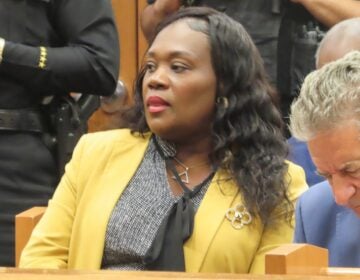Princeton Environmental Film Festival runs March 19-29

Antarctic Edge: 70 Degrees South is showing at the 2015 Princeton Environmental Film Festival. (Photo courtesy of Chris Linder)
Enough already! Enough is the theme for this year’s Princeton Environmental Film Festival at Princeton Public Library March 19 through 29. Enough of damage to coral reefs, wasting precious resources. Enough of climate change and climate change deniers.
Films and speakers selected for the 11-day festival look toward sustainable means of food harvesting and fishing, protecting wildlife, returning walkable communities and fireflies, achieving zero waste, educating kindergarteners in a forest and reversing nature deficit disorder.
There are films for both adults and children: an animated film about a seal child who embarks on an epic journey, films about saving animals, and storytime with author Jared Rosenbaum who will read from his new children’s book, “The Puddle Garden.”
“The films present an opportunity to think about sustainability from a personal perspective in terms of what we buy, how much we think we need, and what we discard as consumers,” says festival director and youth services librarian Susan Conlon. “They also raise the broader question of where we see the tipping point to change course when we decide ‘enough is enough.’ “
The festival includes a number of films made in the Garden State, including “No Pipeline” by Princeton Community TV’s executive director George McCollough and his wife, Anna Savoia; and “Field Biologist” by Edible Jersey editor Jared Flesher, whose earlier films have screened at PEFF.
“Antarctic Edge: 70º South” was produced by Dena Seidel, founding director of the Rutgers Center for Digital Filmmaking in the Mason Gross School of the Arts, and follows a team of scientists who choose a life at sea in the race to understand climate change in the fastest winter-warming place in the world.
The voice over tells us this is the land of the gods, and that it takes longer to get here than to the moon. But it’s not all beauty as we flash to scenes of tropical storms that are the result of rising sea levels, and buildings collapsing into the Ganges.
Seidel and her photographer, Chris Linder, began their six-week voyage with a team of scientists led by New Jersey-based oceanographer Oscar Schofield from Punta Arenas, Chile, the southernmost port to Antarctica. Battling waves 60-feet high, the scientists have, over the course of 20 years, seen winter sea ice decline by three months and temperatures increase by 11 degrees Fahrenheit, six times greater than the global average. Seidel was there to document the work for the National Science Foundation.
“Studying climate change in the most remote part of the world presents scientists with serious challenges as they travel through Antarctica’s perilous terrain,” says Seidel, who also faced those challenges.
The cold and wavy conditions made it hard to film. Seidel’s fingers and the camera batteries would freeze. One camera broke when a big wave landed on deck. “There’s no repair shop, you’re basically on Mars,” she says. Of all the things that could go wrong on the journey – they were a week away from rescue – Seidel’s biggest fear was coming back and not having enough footage for a feature film.
“It’s a race against time,” Schofield says in the film. “Even if we could stop climate change tomorrow, the oceans have so much heat stored and will continue melting ice. The rising ocean temperatures in Antarctica means warming in the U.S. at nearly twice the global rate. Hundred-year storms like Sandy are expected to become 10-year storms. If we don’t adapt, our fate can be similar to the (penguins dying out).”
So what can we do? In “Inhabit” by Costa Boutsikaris, the solution lies in permaculture. The film starts by citing the flaws of our industrial economy with centralization and long-distance transportation, and how it goes against what evolution has done so beautifully on Earth.
For most of human history we have been getting our food from forests. Using the forest as teacher we can create a permanent agriculture – a permanent culture grounded in the resilience of biology. When Ben Falk brought sheep to his farm in Vermont he realized how underutilized grazing material was in creating pure soil. “Grazing animals create lushness on the site,” he says, “putting more fertility into the soil.” Rather than industrial farms, which create massive amounts of waste and leave soil devoid of nutrients, a smart plan involves using waste to help regenerate. Turnips, radishes and rice grow from Falk’s grazing land.
“Inhabit” takes us from Falk’s Vermont farm to suburbs and inner cities, from Massachusetts to New Hampshire, Maine, Brooklyn and the Bronx, showing usthere is no such thing as waste. A composting toilet harnesses human manure from a family that eats healthy organic food to further nourish the garden, rather than using energy to export it from the site. Storm water draining into sewage systems – resulting in raw sewage overflowing into streets – can instead go toward rain gardens and rooftop gardens. Green roofs not only provide food but help absorb rainwater and provide creative jobs. Abandoned gas stations become gardens, and a green playground is a place where children can grow food naturally.
“There is so much amazing work that needs to get done in order for us to restore the great ecosystems of the earth while simultaneously feeding and nurturing its inhabitants,” says Boutsikaris. “Permaculture presents a very clear roadmap for beginning that process and if applied on a large scale could bring millions of new jobs and opportunities for folks looking for purpose and livelihood. It’s the plan where the plants save the planet!”
The complete PEFF schedule. All screenings are at the library unless otherwise noted.
____________________________________________________
The Artful Blogger is written by Ilene Dube and offers a look inside the art world of the greater Princeton area. Ilene Dube is an award-winning arts writer and editor, as well as an artist, curator and activist for the arts.
WHYY is your source for fact-based, in-depth journalism and information. As a nonprofit organization, we rely on financial support from readers like you. Please give today.





